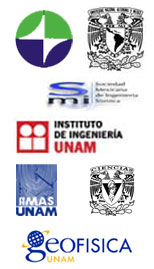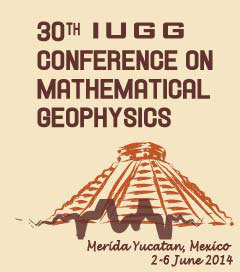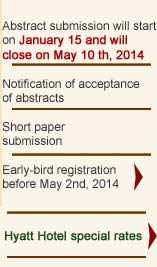
|
Scientific Program
Sessions
*Sponsorship
Travel funds available for early-career scientists>>
Monday June 2, 2014
Inaugural session
Ismael Herrera (Geophysics Institute UNAM) . My life in science, as I understand it today
http://mmc.igeofcu.unam.mx/iherrera
1 .- Monday June 2, 2014
Computational seismology
Convener – Jacobo Bielak (Carnegie Mellon University)
Convener – Héctor Benitez (IIMAS, UNAM)
Invited speaker: Víctor Cruz Atienza
Invited speaker: Leonardo Ramírez-Guzmán (IINGEN, UNAM)
In this session we will cover different aspects of computational simulation in seismology, including both forward and inverse problems in earthquake seismology. Priority will be given to contributions that show innovative mathematical, numerical, or computational methods, especially those that address verification or validation. Applications may include, for example, rupture dynamics, ground motion in complex geological systems with small- scale heterogeneity, and full 3D tomography for crustal structure.
- Ismael Herrera. A powerful software for applying massively parallelized supercomputers to the modeling of geophysical systems
- Molino-Minero-Re, E., Rubio-Acosta, E., Brandi-Purata, J., García-Nocetti, F., Benítez-Pérez, H. Application of multifractal analysis to seismic reflections from a velocity model
- Artur Cichowicz and Hiroshi Ogasawara. Methodology for the Automatic Estimation of Seismic Source Parameters and Updating Corrections for Path Effect
- Víctor M. Cruz‐Atienza, José D. Sanabria, Josué Tago, Emmanuel Chaljub and Jean Virieux. Surface‐Wave Propagation Modes in the Valley of Mexico:Insights from Realistic 3D Earthquake Simulations
- Sunjay and M. Banerjee. Sparse Seismic Signal Recovery By Wavelet Transforms
- Raymundo Domínguez C., Manuel Romero-Salcedo, Luis Velasquillo-Martínez. A methodology to identify complex reflector connections and potentially hidden geological structures on digital images
- González Herrera Raúl, Mora Chaparro Juan Carlos, Aguirre Gonzalez Jorge, Aguilar Carboney Jorge Alfredo, Narcía López Carlos. Estimation of economic loss in structures associated with seismic hazard in Tuxtla Gutierrez
- Peter G. Malischewsky and Francisco J. Sánchez-Sesma. The 50 years of Herrera's orthogonality relation and beyond (a review)
- Mathieu Perton, Marcial Alberto Contreras Zazueta, Francisco J. Sanchez-Sesma. The Indirect Boundary Element Method (IBEM) for Seismic Response of Topographical Irregularities in Layered Media
- Zachary E. Ross and Yehuda Ben-Zion. Automatic picking of direct P, S seismic phases and fault zone head waves
- Zachary E. Ross and Yehuda Ben-Zion. An earthquake detection algorithm with pseudo probabilities of multiple indicators
- Leonardo Ramírez-Guzmán, Moisés Contreras Ruiz Esparza, Jorge Aguirre González, and Jacobo Bielak. Ground Motion Analysis in the Valley of Mexico Using Large Scale Numerical Simulations
- Rubio-Acosta E., Brandi-Purata J., Molino-Minero E., García-Nocceti F., Benítez-Pérez H. Methodology for graphical analisys of seismic records based on self organized maps (SOM Neural Networks) and Wavelet transform
- Silvia R. Garcia and Juan M. Mayoral. Soils vibrating, determinism or chaos
2.- Monday June 2, 2014
Four paradigms in predicting extremes: Legacy of Vladimir I. Keilis-Borok
Conveners - Alik Ismail-Zadeh,Karlsruhe Institute of Technology, Germany
Ilya Zaliapin, University of Nevada Reno, USA
Yehuda Ben-Zion, University of Southern California, USA
Invited speaker: George Molchan, Russian Ac. Sci., Russia
Invited speaker: Andrei Gabrielov, Purdue University, USA http://www.math.purdue.edu/~agabriel
Invited speaker: Maxim Arnold, Russian Ac. Sci., Russia
Invited speaker: Antonella Peresan, University of Trieste, Italy
http://www.geoscienze.units.it/esperimento-di-previsione-dei-terremoti-mt.html
Invited speaker: Jorge Ramirez, National University of Colombia, Colombia
Invited speaker: Robert Shcherbakov, Western University, Canada
Natural and socio-economic disasters pose an intolerable threat to society. The most damaging and least understood in this realm are extreme events, also called critical transitions, disasters or catastrophes. The symposium will review the state of the art and outline directions for future research in the science of forecasting extreme events. The symposium will bring together the world-leading experts in the field as well as researchers from the new generation to discuss the mathematical problems of risk assessments, forecasting, impact evaluation, and designing the corresponding mitigation strategies. The goal is to showcase the recent progress, share the knowledge among different disciplines, and develop tools that can be used by disaster management authorities. The symposium is dedicated to the memory of Professor Vladimir Keilis-Borok who passed away on October 19, 2013. During the 20th century, Vladimir Keilis-Borok has pioneered applications of mathematical, probabilistic, and computer methods in seismology. Vladimir Keilis-Borok has founded the Working Group on Geophysical Theory and Computers (WGGTC), which later had transformed into the IUGG Commission on Mathematical Geophysics (CMG). Professor Keilis-Borok was Vice President of the International Association of Seismology and Physics of the Earth Interior (IASPEI). During 1987-1991 he was the President of the IUGG.
3.- Tuesday June 3, 2014
Nonlinear phenomena in the climate system
Convener- Henk Dijkstra (Institute for Marine and Atmospheric research Utrecht - IMAU)
Convener- Chris Jones (University of North Carolina, USA)
Invited speaker: Mickael D. Chekroun (University of California, Los Angeles USA)
Invited speaker: Michael Högele (Universität Potsdam)
Nonlinear processes affect the behavior of most phenomena in the geosciences. The climate system, in particular, is an example of a nonlinear system in which
interactions between many different processes take place on a multitude of temporal and spatial scales. These nonlinear interactions lead to strong internal variability, due to the existence of substantial instabilities and related feedbacks. The resulting, highly complex intrinsic variability interacts in turn with the time-dependent variations in the forcing and gives the rich and intriguing behavior that is documented in the instrumental data and proxy records.
The theory of nonlinear, stochastic dynamical systems provides a systematic methodology, as well as a synthesizing framework to understand the behavior of complex systems. Over the last decades, the application of this theory to climate variability has provided many new insights into mechanisms of internal variability. In addition, many of the concepts are used now in nonlinear methods of data analysis, stochastic parameterizations, data assimilation techniques and predictability studies. In this session, we welcome work related to the broad theme of nonlinear phenomena in the climate system or any of its components (ice, ocean, air, land, life), preferably studied within the nonlinear stochastic dynamical systems framework.
4.- Tuesday June 3, 2014
Mathematical and numerical modeling of enhanced oil recovery
Convener – Luis Miguel de la Cruz (Geophysics Institute UNAM)
Convener – John Chen (University of Calgary)
Invited speaker: Dr. Renee Perez Rodriguez. Information about the speaker can be found at: http://www.geochemicalengineering.com/people.html
Enhanced Oil Recovery (EOR) is a term used to identify sophisticated techniques to increase the recovery of hydrocarbons from oil fields.
Complex chemical and thermal effects are the main processes used in several different EOR methods. Numerical simulation of these processes is required to design new technologies for exploration and production of oil and gas.
The complexity of the mathematical models of EOR requires devising of sophisticated and efficient numerical strategies to obtain accurate solutions of these models. EOR is a large-scale problem with growing computational demands; therefore, parallel computing is a practical route to effectively solve these kinds of problems.
The objective of this session is to bring together researchers from several fields of knowledge, with interest in oil recovery applications. Works covering different aspects of computational modelling of hydrocarbons recovery are welcome, such as: mathematical formulations of the involved phenomena; devising of new numerical strategies; computational implementation, serial and parallel, of algorithms; analysis and validation of numerical results.
- Julián Tercero Becerra Sagredo, Carlos Málaga and Francisco Mandujano. Compositional flow in porous media using GPUs
- Octavio Cazarez-Candia, Pedro V. Verazaluce-Barragán. Numerical simulation of in-situ combustion in experimental tubes with homogeneous and fractured system
- D. Cervantes, R. Leriche, A. Salazar, L.M. de la Cruz. Parallel simulation of the black-oil model using streamlines on non-orthogonal domains
- Jesús Manuel Chaidez Félix, Jorge X. Velasco Hernández and Edscott Wilson García. Fractal properties in naturally fractured reservoir
- Graciela S. Herrera and Ismael Herrera. Unified formulation of enhanced oil-recovery methods
- Gustavo Ramos, L.M. de la Cruz, I. Herrera, Emilio Zavala and Rafael Vargas, Mathematical, numerical and computational models of compositional oil based on streamlines
- Renee J. Perez and Marcelo Epstein. Optimization of equations of state using the direct search method
- Teresa Pérez Muñoz, Eliseo Hernández Martínez and Jorge X. Velasco Hernández. Fractal Analysis of Geophysical Signals for Oil Reservoir Characterization
- Norberto C. Vera Guzmán. Traced Streamlines Using Mixed Models
- E. Zavala, L. Naranjo, L.M. de la Cruz, R. Perez. Accelerated PVT flash calculations using GPUs
5.- Wednesday June 4, 2014
Fluids, friction and rheology, in rocks and porous media
Convener - Renaud Toussaint (Univ. Strasbourg, France)
Convener – Graciela Herrera-Zamarrón (Geophysics Institute UNAM)
Invited speaker: Stefan Nielsen
Invited speaker: David Sparks
Understanding friction and the localization of deformation is essential in Earth science systems. Notably, it is key to understand the initiation and the mature functioning of faults, in more or less permeable and fractured rocks (as e.g. in reservoirs). Different types of friction and rheological changes are also at the heart of numerous surface phenomena: to name a few, avalanches and gravitational instabilities in soils and granular media, or liquefaction events, some types of eruptions. They also impact problems related to industry and geotechnics, as during drilling activities and reservoir exploitation.
In many of these systems, fluids and their transport play a key role: both from a physical point of view, to exchange momentum while fluid seeps through pores and fractures, or from a chemical point of view, to dissolve and precipitate material, change the physical properties of the medium, transport material, clog porosity. It also plays a key role in the transport of energy and in the determination of the temperature field. In many physically coupled systems, the presence of fluids and fluid interfaces, their composition and temperature can affect frictional properties and trigger phase changes in the material, e.g. during thermal pressurization episodes.
This session welcomes contributions on this wide range of phenomena related to rheology, friction and fluids in rocks and soils: We wish to gather several points of views, and welcome contributions on diverse angles on this topic, or a combination of such - between physical and analytical theory, numerical modeling, experimental approach, and field characterization and observation.
- Stefan Bjorklund Nielsen, Elena Spagnuolo, Marie Violay, Giulio Di Toro. Heat, fluids and weakening: experimental clues on the microscale processes of high velocity sliding friction.
- David W. Sparks, Ronald Bianco, Einat Aharonov, Renaud Toussaint, Liran Goren. Interactions between pore fluid and granular dynamics in shearing fault gouge
- Álvaro A. Aldama and Ismael Herrera. Stability and spectral attributes of numerical solutions of Richard’s equation
- Cécile Clément, Renaud Toussaint, Menka Stojanova), Einat Aharonov, Céline Fliedner, Gustavo Sanchez, Ernesto Altshuler), Alfo Batista, Eirik Grude Flekkoy. The art of sinking: influence of water on seismic liquefaction and quicksand dynamics
- Jon Alm Eriksen, Bjørnar Sandnes, Renaud Toussaint, Knut Jørgen Måløy, and Eirik Flekkøy, Fingering during dyke formation - Gravity Induced Ordering of Frictional Fingers
- Maxime Farin, Semih Turkaya, Fredrik Kvalheim Eriksen, Anne Mangeney, Julien de Rosny, Nikolaï Shapiro, Knut Jørgen Måløy, Eirik G. Flekkøy, Megan Zecevic, Guillaume Daniel and Renaud Toussaint. Characterization of blocks impacts and fluidofracture processes from acoustic emissions: energy partitioning, laboratory experiments using optics and accelerometry
- Guillermo Hernández-García. DDM applied to subsurface flow and transport
- Martínez-Morales, Manuel, Gutierréz-Ojeda, Carlos and Bonola Isaac. Field characterization and numerical modeling of an unstable soil
- Onifade, Yemi Sikiru, Akinyemi, Olukayode Dewumi. New determined thermal conductivities of some topsoils using improved block method
- Zachary E. Ross, Yehuda Ben-Zion and Lupei Zhu. Isotropic source terms of San Jacinto fault zone earthquakes based on waveform inversions with a generalized CAP method
- Lucía Torres Fernández, Víctor Manuel Hernández Madrigal, Francisco Javier Domínguez Mota. Focoused through the conditional probability GIS to create a map of the landslide susceptibility in the municipality of Angangueo, Mich.
- D. Zigone, Y. Ben-Zion and M. Campillo. Modeling slow slip events, non-volcanic tremor and large earthquakes in the Guerrero subduction zone (Mexico) with space-variable frictional weakening and creep
6.- Wednesday June 4, 2014
Ambient seismic noise, diffuse fields and interferometry
Convener – Francisco Sánchez Sesma (Engineering Institute UNAM)
Convener – Michel Campillo (ISTerre, University J Fourier, Grenoble)
Invited speaker: Nishida Kiwamu, Earthquake Research Institute, University of Tokyo
Invited speaker: Joost van der Neut Delft University of Technology
The retrieval of Green´s functions from the average of cross-correlations of ambient fluctuation within a diffuse field has attracted considerable attention from different areas of geophysics. In fact, ambient seismic noise and coda waves can be used to infer information of mechanical properties of Earth. For a variety of linear systems the formal derivation can be obtained from representations in normal modes and plane waves. Time-reversal and representation theorems have been used as well. Closely related is interferometry in which cross-correlations are useful to produce virtual sources and to improve the illumination for imaging purposes. This session is concerned with theory and applications of diffuse fields and interferometry in geophysics. The emphasis will be laid to mathematical, numerical or computational innovative contributions.
- Xin Liu and Yehuda Ben-Zion. Inversion of inter-station attenuation from ambient seismic noise records on a linear array
- Dylan Mikesell and Alison Malcolm, Investigating isolated velocity changes with coda waves and the dynamic warping method
- Kiwamu Nishida. Seismic interferometry in the global scale: seismic exploration
using seismic hum
- Joost van der Neut, IvanVasconcelos and KeesWapenaar. An interferometric interpretation of Marchenko redatuming
- Piero Poli, Pierre Boue, Michel Campillo, Helle Perdersen, Christine Thomas. Exploring the core mantle boundary with seismic noise
- Francisco J. Sánchez-Sesma, Michel Campillo, Ursula Iturrarán-Viveros, M. Perton, José Piña-Flores, Juan Camilo Molina-Villegas, , Juan J. Perez-Gavilán, Hiroshi Kawase and Shinichi Matsushima. A Theory for H/V Spectral Ratio based on the Diffuse Field Assumption
- D. Zigone, Y. Ben-Zion, M. Campillo and P. Roux. Multi-scale noise-based imaging of the San Jacinto Fault Zone environment
- Mathieu Perton and Francisco J. Sanchez-Sesma. Normalization during the process of noise correlation
- Michel Campillo, Pierre Boué, Piero Poli, Helle Pedersen and Philippe Roux. Correlations at the global scale and retrieval of the deep seismic phases in presence of reverberations, coda waves and ambient noise
7.- Thursday June 5, 2014
Field trip to Chichen-Itza (optional) >>
8.- Friday June 6, 2014
Surface-atmosphere interaction
Convener - Fabio D'Andrea (ENS, France)
Convener - Arón Jazcilevich Daimant (Atmospheric Sc. Center UNAM)
Invited speaker: Dr. Victor Brovkin from Max Planck Institute for Meteorology
Information about the speaker can be found at: ttp://www.mpimet.mpg.de/en/staff/victor-brovkin.html
Invited speaker: Sasha Madronich from National Center ofo Atmospheric Research
Information about the speaker can be found at: http://acd.ucar.edu/~sasha/
In this session we accept contributions analyzing all the exchanges and feedbacks at the surface interfaces of the planet. These include physical and biogeochemical processes happening at the most diverse time and space scales, involving the interaction of the atmosphere with the continental land surface and the oceans. Priority will be given to contributions showing innovative mathematical, numerical or computational methods. Applications may include for example the atmospheric interactions of surface hydrology and vegetation, the urban atmosphere dynamics, land-use change effects and extreme weather events.
|

|





